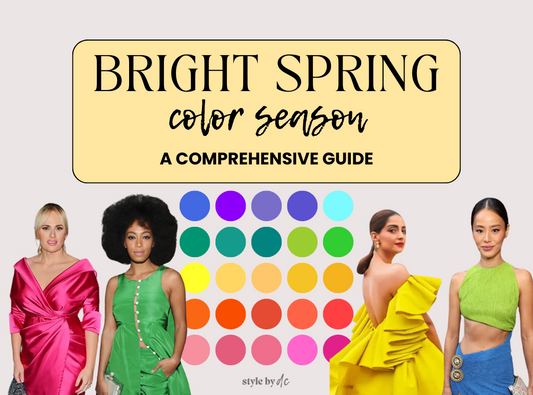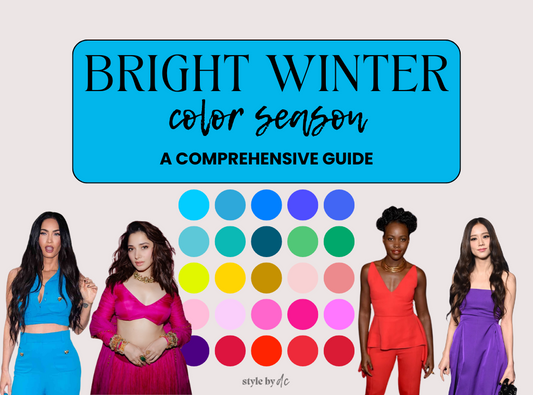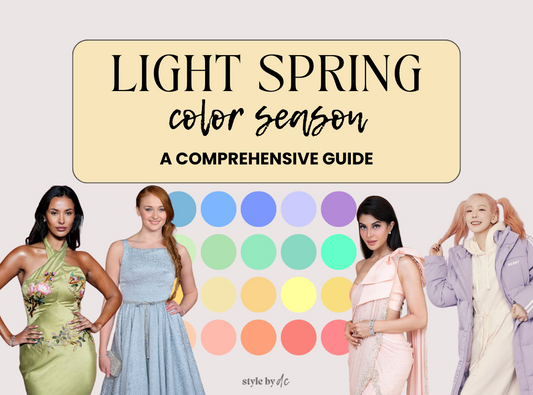The Allure of the “Perfect Season”
The moment someone discovers their seasonal color palette can feel like a light switch flipping on. After years of wondering why certain colors make you look tired while others make you glow, the idea that you have a “best palette” feels like the ultimate answer.
The 16 season color analysis system is a refinement of the classic 4-season method. It doesn’t just lump people into “Winter” or “Summer”—it considers hue (warm vs. cool), value (light vs. dark), and chroma (soft vs. bright) to arrive at a more nuanced result: like True Summer, Light Spring, or Dark Autumn. Each 16 season method adds additional categories for those that feel like they are a bit “in between”. For example, if you feel like you’re a bit in between Winter and Summer - there are the options of Deep Summer and Soft Winter.
It’s no wonder people feel like they’ve struck gold when they find their season. A quick scroll through Reddit or YouTube shows the popularity of the seasonal color analysis quiz, and the search for colour analysis near me or personal colour analysis near me is growing every year.
There’s power in feeling seen. There’s comfort in having a name for something that always felt off. But there’s also a risk in thinking this is the full story.
Color analysis is a checkpoint on your style map—but it’s not the destination.
What It Can Tell You (and Why That Matters)
At its core, color analysis is about identifying the undertone, depth, and chroma that naturally harmonize with your features. When someone is accurately draped in-person or virtually —using color analysis drapes—you can often see it immediately: their eyes look brighter, their skin more even, their features more balanced.
Whether you fall into autumn color analysis with its rich, earthy tones or the spring color analysis palette full of warmth and light, discovering your best palette offers some real, tangible benefits:
- A curated starting point: Instead of wondering where to begin in the makeup aisle or clothing rack, you suddenly have a palette of colors that are more likely to flatter you. It simplifies decision-making, especially if you’ve struggled with indecision in the past.
- Better hair decisions: Many clients use their season to guide a subtle shift in hair color. (Hair color analysis is often one of the most game-changing results of a seasonal consult.) Picking the wrong tone can make your hair color feel disconnected from your skin and eyes, even if it’s technically a “good” color.
- Relief and validation: "This makes sense now" is a phrase I hear all the time. Color analysis gives language and clarity to instincts you may have had for years. Clients often reflect on past style regrets through a new lens—why that coral dress always got compliments, or why dusty mauve always made them feel tired.
- Immediate visual feedback: For many people, especially in person, the difference between the right and wrong palette is stark. One brings out glow and presence; the other mutes or shadows. Even skeptical clients can be surprised when their face visibly lifts with the right drape.
- A more cohesive wardrobe: Once you start buying items within your palette, it’s easier to mix and match. Everything goes together more intuitively, and the “I have nothing to wear” feeling happens less often.
This is why color analysis is so addictive. When it’s accurate, the transformation is undeniable.
If you're ready for the first step, start here:
What It Can’t Tell You
For all its strengths, color analysis is not a magic wand. It won’t solve your entire relationship with clothing, identity, or style—and expecting it to can lead to frustration.
Here’s what seasonal color analysis can’t do:
❌ It won’t automatically solve a style identity crisis
Knowing that the True Winter seasonal palette is your best won’t clarify whether you prefer structured tailoring or romantic ruffles. You can have 10 women that suit the same season with wildly different vibes. The palette gives you the colors—but not the cut, the texture, or the story.
❌ It doesn’t account for your lifestyle, culture, or personality
Are you a mom of three juggling a fast-paced schedule? Do you work in a conservative office or run your own creative business? Do you love vintage silhouettes or minimalism? None of that is visible through your draping process, but it all plays a role in how your style needs to function. Culture and tradition also shape how we dress—and color can support that, but it shouldn’t dictate it.
❌ It doesn’t tell you what kind of woman you’re becoming
Style is a tool for self-construction. Color analysis gives you a foundation, but only you can decide the feeling you want your clothes to evoke: freedom? power? softness? rebellion? Just because magenta is in your palette doesn’t mean it aligns with your current chapter. It’s okay to evolve and re-interpret.
❌ It won’t fix your shopping habits
If you don’t have a plan, you’ll still buy things you never wear—even in your season. Unless you know how to apply your palette intentionally, you may just end up with a different kind of clutter. A closet full of “right” colors that don’t actually suit your lifestyle, your goals, or your taste is just as frustrating as a closet full of random sale finds or influencer-suggested items.
Tools like a color analysis quiz and a search for personal color analysis near me can spark curiosity—but they don’t replace deep personal reflection.
Why High-Intent Clients Use It Differently
Here’s the difference I see in clients who get lasting value from color analysis: they aren’t just trying to look “put together.”
They’re using it to support something bigger.
You’re not just trying to “look pretty” — you’re trying to show up differently. You’re looking for alignment between your appearance and your identity. You want clothes that reflect how you feel inside—or how you want to feel. You want to be clear, not performative. Authentic, not curated.
In this context, color becomes a tool for clarity—a visual language that supports who you are and where you’re going.
It’s not uncommon for high-intent clients to come to me during periods of transition: career changes, moves, major birthdays, identity shifts, creative renaissances. Color analysis becomes a compass, not a cage.
“It finally gave me permission to stop chasing styles that never worked for me,” one client said. “Now I use my palette to edit, not to limit.”
Another client told me, “I realized I’d been dressing for who I thought I should be. This helped me start dressing for who I actually am—and who I’m becoming.”
Whether you're exploring summer color analysis for its soft cool tones or searching colour analysis Toronto or colour analysis Niagara Falls to find the right expert, the goal isn’t to obey the rules. It’s to find your center—and move outward from there.
Color Analysis Is a Tool, Not a Rule - Or a Box
The 16 season color analysis system is powerful—especially when it’s used as a launch point, not a fixed identity. When you combine it with intentional self-reflection, it becomes one of the most grounding tools in your style journey.
But it’s not the destination. It’s a mirror, not a mold.
The right palette can affirm your beauty, highlight your strengths, and support your style journey—but it works best when paired with questions like:
- How do I want to feel when I get dressed?
- What do I want my clothes to communicate?
- What version of myself am I stepping into?
If you're ready to connect your palette to your real life—your wardrobe, your hair, your style goals—that’s where I come in. My full color analysis sessions and Style Discovery calls are designed to go deeper. We don’t just name your season. We use it to build a style that feels completely like the woman you want to be.
Ready to build a style that reflects the whole picture? Let’s start there.



